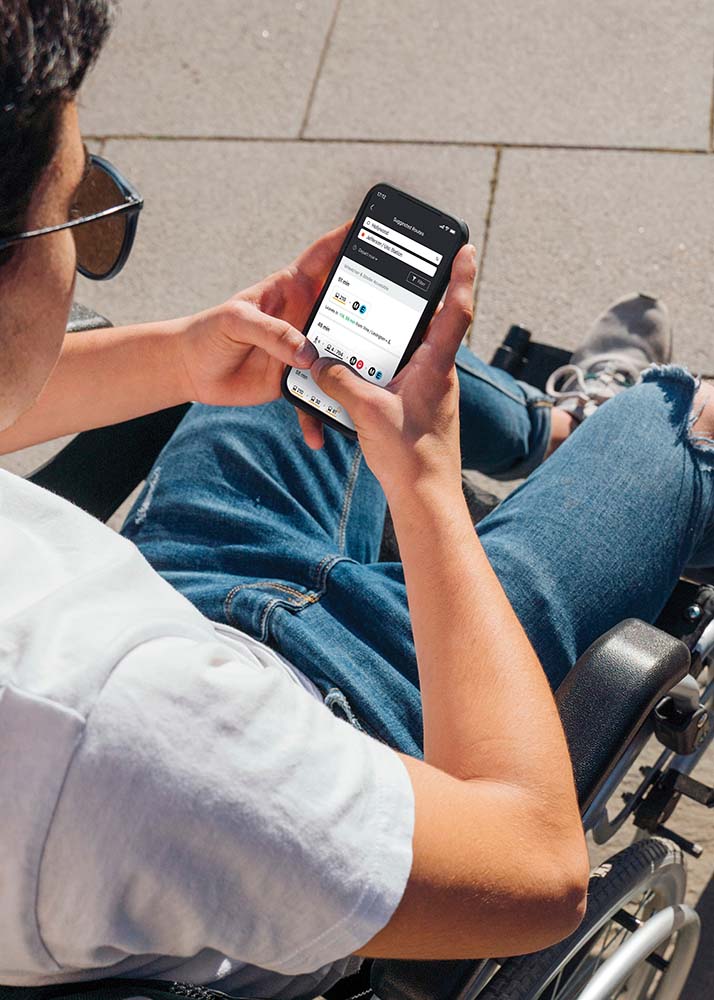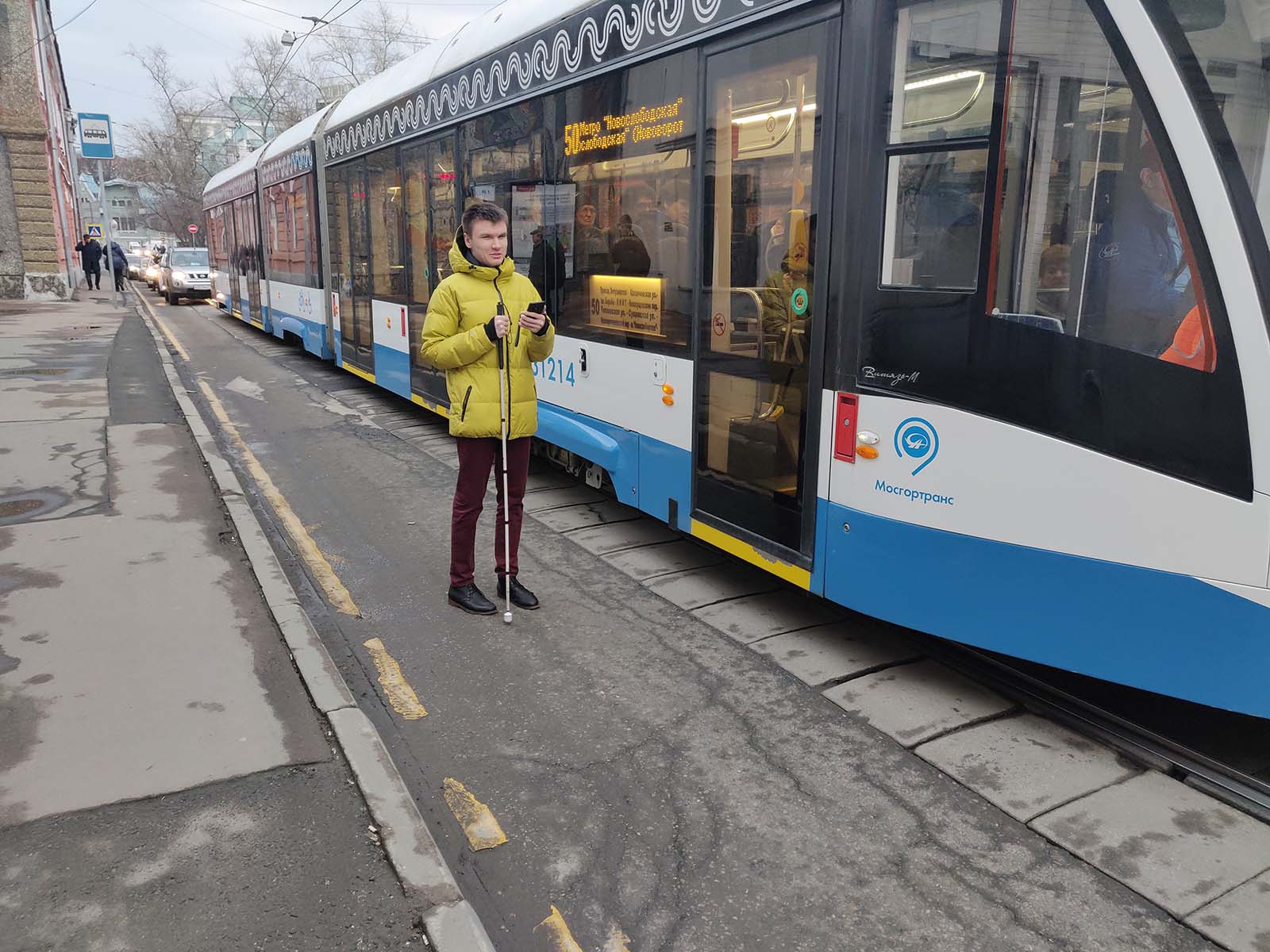Alexandr Epaneshnikov, a 19-year-old Russian student who is legally blind, recently decided he wanted to be more independent by commuting on his own and relying less on his mom for rides to school. It meant taking a streetcar to a subway to his high school in Moscow, a 30-minute trip that Epaneshnikov assuredly navigates with a cane and Moovit, an urban mobility app optimized for screen readers.
“I am very happy that Moovit is accessible and offers a good amount of information about Moscow public transportation,” says Epaneshnikov, who wants to study information technology at a university. The app has helped him meet friends at cafes and restaurants, and take a train to an unfamiliar city outside Moscow to visit his girlfriend’s family.
“I feel it adds more confidence and independence,” he says.
Launched seven years ago in Israel, Moovit has become the world’s most popular transit-planning and navigation app, with more than 400 million users and service in 2,700 cities across 90 countries. The company is also a leader in inclusive technology, with innovative work that helps people across the disability spectrum use buses, trains, subways, ride-hailing services and other modes of public transit.
In addition to offering a consumer app in 45 languages, Moovit has partnered with Microsoft to provide its multi-modal transit data to developers who use Azure Maps, and a set of mobility-as-a-service solutions to cities, governments and organizations. The partnership will enable the creation of more inclusive, smart cities and more accessible transit apps.

Yovav Meydad, Moovit chief growth and marketing officer. (Photo courtesy of Moovit)
“Our mission is to simplify urban mobility and make it accessible, because mobility is really a basic human right,” says Yovav Meydad, Moovit chief growth and marketing officer. “Efficient mobility opens a lot of opportunities for employment, education and a better life, and we want to help all users make their journey as easy as possible.”
For Moovit, the work means not only helping rural residents reach cities for work and school, but also helping people with any disability travel. Of the hundreds of daily emails sent to Moovit, emails from people with low vision are some of the most profound pieces of feedback.
“Sometimes, it’s very emotional,” says Meydad. “They say, ‘Thanks to Moovit, I’m more independent. I can now leave home on my own.’ It’s very, very important for us to make Moovit accessible for everyone.”
The company’s accessibility work began in earnest in 2015, when Meydad and other leading app developers met a focus group of people who are blind or low-vision to see how they used their apps.
“Honestly, I was shocked,” says Meydad, who wrote about the experience twice in Medium. “I saw people trying to use our product, but couldn’t do it efficiently or at all, because screens were not properly labeled or meaningful [for screen readers].” In one case, Moovit’s search button – a major feature to start a trip plan – had the unhelpful audio label of “Button 56.”
Meydad took notes and promised big changes. He worked with Moovit’s team and a developer who is blind to optimize the app for the mobile screen readers TalkBack on Android and VoiceOver on iOS. The team scrutinized every screen for accessibility, added useful labels and condensed intricate data – routes, trip duration, start and end times, entry and exit stops – into clear sentences for audio. They incorporated feedback from users around the world with low vision.
“After one quarter, we released a major version upgrade that completely changed their experience,” says Meydad.
The accessibility work didn’t stop there. To ease public transit for people who use a wheelchair, Moovit asked its “Mooviters” – 550,000 local contributors who help map transit systems for the app – to identify wheelchair-accessible stations in their cities. That enabled the company to add a feature that shows only routes with stations with ramps and elevators.
“This means the entire journey can be fully accessible,” says Meydad.
For users with hand motor disabilities, Moovit redesigned menus and buttons for easier use with one hand, especially on larger phones. For people who are colorblind and use color-coded transit systems, such as “the green line,” Moovit includes the name of the line, instead of just a colored dot or symbol, a space-saving practice in many maps.
The company also ensures no broken or overlapped text when a user needs to magnify the font. It partnered with Be My Eyes, an app that connects sighted volunteers with people who are blind or low-vision. It’s studying how to use a phone’s vibration and flashlight to serve users with hearing loss. And it continually works with people with a disability to improve or customize the app.

A Moovit user in a wheelchair uses the app. (Photo courtesy of Moovit)
For Microsoft, working with Moovit, who has developed accessible features such as screen readers and global data on wheelchair-friendly routes, is part of a deep commitment to accessibility and inclusion in its products and services. Developers who use Azure Maps will soon have access to Moovit’s trip planner and rich transit data to help build innovative, accessible tools.
“What I love most about Moovit is how they’re empowering other companies to build inclusion into their solutions,” says Megan Lawrence, senior accessibility evangelist at Microsoft. “Our partnership can help people across the disability spectrum use technology to move more freely and independently, a key metric for improving quality of life.”
The clarity of Moovit’s live audio navigation also helps people with an intellectual disability who want extra guidance, such as alerts for when a bus is coming, when to transfer and when to get off. The features are a main reason why Community Living Toronto, an organization that supports people with an intellectual or developmental disability, chose Moovit as the platform for their branded transit app, Discover My Route.
“We tested many apps and Moovit was the full package,” says Angela Bradley, director of resource development and marketing at Community Living Toronto.
“It’s not just an app for riding transit. It’s almost like a coaching tool. It gives people the confidence to take transit and open up their world, which can mean seeing friends, getting a job, going to college or joining a dance class.”
Top photo: Alexandr Epaneshnikov in Moscow. (Photo courtesy of Epaneshnikov)

